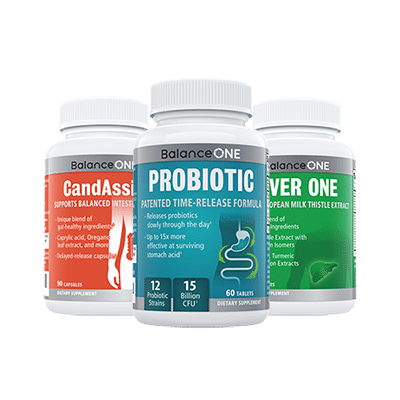The Gut-Skin Connection: How An Imbalanced Gut Can Damage Your Skin

The average person has around 300 million skin cells, making it the largest organ in your body. It’s great to have healthy and glowing skin, both for your wellness and for your self-confidence.
Your skin is a hard-working organ that accounts for around 15% of your total weight. It allows you to regulate your body temperature, letting you know if you are too hot or too cold. It is your first line of defense against infectious organisms, and a protective barrier keeping your internal organs, bones, and muscles safe from damage and disease.
Changes in your skin can be indicative of changes to your overall health. Acne, psoriasis and other skin issues can be a sign of problems somewhere else in the body.
Perhaps you’ve heard of foods that trigger acne outbreaks or that lead to eczema. Recent research has found a definitive link between the gut and skin. This link between these organs is referred to as the gut-skin axis. (1)
Do you know someone who enjoys eating fast food and drinking soda at every meal? Their skin tends to look blotchy, dry, and unhealthy.
Table Of Contents
The Skin Microbiome
Over 1000 species of bacteria and call your skin home. They are beneficial bacteria, and most of the time they cause no adverse health effects.
These bacteria help to uphold your skin health in the same manner that the friendly bacteria found in your gut assist with your digestive health.
The microbiome of both your gut and skin should contain as many varieties of healthy bacterial strains as possible. The bacteria on your skin plays a role in keeping your skin hydrated and elastic, maintaining overall skin health and in reducing acne, spots and pimples. (2)
Your skin microbiome is highly specialized. The microorganisms have adapted to survive on the low level of nutrients present on the skin. These microbes produce substances that prevent harmful bacteria from multiplying so they cannot colonize the skin.
A healthy skin microbiome should remain balanced despite what is happening in the surrounding environment. When dysbiosis or imbalance occurs in the skin microbiome, skin diseases can appear. (3)
Researchers recently discovered that it is not, in fact, a specific type of bacteria that causes acne, but rather an imbalance in the skin’s bacterial colonization.
The bacterium Propionibacterium acnes is frequently cited as the cause of acne. However, it has been found that this bacterium is found on the skin at similar levels in both people who experience acne and in those who don’t. It is likely that imbalances of the microbiome are to blame, and not the P. acnes. (4)
A Healthy Gut Means Healthy Skin
The health of your gut is vital to that of your skin. The gastrointestinal tract is an extremely complex system that starts at the mouth and continues through the stomach, small and large intestines before terminating with the rectum and anus.
Your GI tract is responsible for absorbing the nutrients in your food, removing toxins and waste products from the body, managing inflammation, and preventing infections from harming you (your gut is home to over 70% of your immune cells!) (5)
Your gut is a very complex system, and the way it reacts to your diet will have an impact throughout your body. A healthy, balanced diet rich in fiber will support your gut health and allow the beneficial bacteria in the microbiome to thrive.
The opposite is true of an unhealthy diet that is high in refined sugar and carbohydrates, fast food, and processed meat. These foods can give rise to an overgrowth of harmful microorganisms in the digestive system, causing dysbiosis which in turn can give rise to health complications.
The Gut-Skin Axis
Your skin and gut work in harmony. The digestive system removes toxins from your body either from your diet or bodily processes, and these toxins are excreted, in-part, through your skin. The higher the volume of toxins in your body, the higher the amount excreted through the skin which in turn, can cause skin problems. Signs of an unhealthy gut will often be displayed on the skin before showing signs elsewhere.
Chronic skin conditions such as psoriasis frequently have an underlying cause in the intestines.
For example, research shows that people with psoriasis have less diversity in the gut microbiome than individuals who do not suffer from psoriasis. (6)
Another example is rosacea, which has been linked to small intestinal bacterial overgrowth (or SIBO). Researchers found a link between SIBO and rosacea when they used antibiotics to treat and clear the SIBO. For most study participants, their rosacea also disappeared. (7)
Imbalances like Candida overgrowth and SIBO can lead to damage in the lining of the intestines, which causes a further condition called leaky gut. When the gut membrane becomes permeable, it can lead to chronic inflammation and a range of symptoms. This can contribute to skin conditions such as hormonal acne, eczema, rosacea, and psoriasis.
Foods to Avoid For Healthy Skin
If you support your gut through a healthy diet, then you may find those common skin problems such as acne and eczema become a distant memory.
For Acne
Most importantly, avoid or reduce your intake of refined carbohydrates. These include white sugar and grains that have had all their nutrients stripped away. Examples are white flour, white rice, breakfast cereals, pasta, pizza dough, and bread.
Foods such as these are quickly digested and cause a spike in blood sugar. An increase in insulin to cope with the rise in blood sugar quickly follows, and it’s this spike in insulin that has been shown to stimulate oil glands on the skin to produce oil, leading to an increased likelihood in developing acne. (8)
For Psoriasis
Psoriasis is a chronic autoimmune disease in which your immune system attacks healthy cells in your body instead of attacking infectious microorganisms.
The life-cycle of the skin cells is quicker than normal with psoriasis, leading to an accumulation of cells on the skin surface, forming scales and patches of red, irritated skin that are itchy and painful.
Maintaining a diverse gut microbiome is vital; sufferers of psoriasis have a much smaller range of bacteria in their gut microbiome. The microbiome is essential for health, and it should come as no surprise that if it is unbalanced, problems such as psoriasis will follow. (9)
Inflammatory foods to avoid include red meat, fried food, pasta, pastry, and bread. Not surprisingly, sugar is also an inflammatory food that produces toxins named advanced glycation end products (AGEs). AGEs cause inflammation, which leads to psoriasis and other conditions.
What To Eat For Healthy Skin
To avoid skin problems, eat a diet that is low in sugar and inflammatory foods and high in anti-oxidants.
Problems with the skin can be traced to dysbiosis of the gut microbiome, so include a good quality probiotic to support both gut and skin health. Here are some of the foods that you should include in your diet if you want skin that glows with health.
Oily fish
Fish, especially fatty or oily fish, is an important component of a healthy diet. Wild-caught salmon and herring are some varieties of oily fish that are also low in heavy metals and other toxins.
These fish are high in omega-3 fatty acids which help to keep skin hydrated and supple. Deficiencies in this fatty acid can often be noted in the first instance due to dry, flaky skin. (10)
Omega-3 fatty acids reduce inflammation in the body and help with autoimmune disorders such as psoriasis and lupus. (11)
Fatty fish also provides you with zinc, a mineral that is essential to produce new skin cells. A deficiency in zinc can lead to skin inflammation and lesions. You will also find an abundance of the antioxidant vitamin E in fatty fish, which protects against inflammation and oxidative damage caused by free radicals. Don’t forget that fish, in general, is an excellent source of the protein which your skin requires for health. (12)
Low-sugar fruits and vegetables
A diet full of healthy produce is the cornerstone to health. Wherever possible choose organic produce that is not tainted by harmful chemicals and will provide you with the optimal amounts of nutrients. All plant-based nutrition is good for your skin and gut health but here are some superstars that you should include in your diet:
Avocados
These superfruits contain both vitamin E and C and healthy fats. In an extensive study of over 700 women, those that ate a diet high in the types of healthy fat that we can find in avocado were found to have more supple and healthier skin than those who did not eat these fats. (13)
As with fatty fish, avocados are high in the antioxidant vitamin E. This is more effective when it is eaten in combination with the vitamin C, which is also needed to create the structural protein collagen. (14)
Broccoli
This green vegetable is packed with zinc, vitamins A and C, and lutein. Lutein is a carotenoid that protects your skin from that oxidative damage that leads to wrinkles and dryness.
Broccoli is also a source of the compound sulforaphane which has been found to protect against the damage that can be caused by the sun. (15)
Nuts and seeds
Lots of skin-supportive nutrients are found in nuts and seeds. Walnuts contain essential fatty acids and are a more concentrated source of omega-3 fatty acid than other nuts. They contain zinc, the antioxidant vitamins E and C, and selenium which all help to combat inflammation and infection.
Sunflower seeds are a rich source of vitamin E, selenium and protein, all of which will help your skin to heal, fend off infections and glow with health.
Probiotics
A convenient way to assist your gut and skin microbiome is through taking a daily probiotic supplement which contains beneficial bacteria.
If your gut microbiome is unbalanced due to a Candida overgrowth, a poor diet or a course of antibiotics, probiotics will assist your microbiome in regaining a healthy balance.
Bear in mind that not all probiotics are created equal and it is essential to select a high-quality product that can do the job it claims.
Select one that uses BIO-tract time-release technology to ensure that the good bacteria reach your gut. Also examine the CFU of the probiotic, which stands for colony forming unit. It indicates the volume of live and active bacteria. Look for a minimum of 10 billion CFUs to ensure that a useful number of live bacteria arrive in your gut.
My preferred probiotic is the Balance ONE Probiotic, which I have described in more detail here.
You Are What You Eat
For optimal health, your gut requires a wholesome diet that provides your body with the correct vitamins, minerals, and nutrients. Your gut microbiome will also benefit from probiotics and this, in turn, will benefit your skin.
It might be an old adage, but it still rings true: you are what you eat. Your skin is in many ways a mirror of your gut. If your digestive system and its microbiome are healthy, then your skin will reflect this with a smooth, infection-free dermis and a radiant glow.

3-Month Candida Elimination Kit Start Your 3-month Candida Cleanse
This Candida Kit contains all the supplements recommended on the Candida Diet:
- LIVER ONE to process and remove the toxins created by Candida.
- CANDASSIST to inhibit and weaken the Candida colonies in your gut.
- PROBIOTIC to replace the Candida yeast with probiotic bacteria.
Plus... the CANDIDA DIET RECIPE BOOK with 50+ low-sugar recipes

Leave a Reply